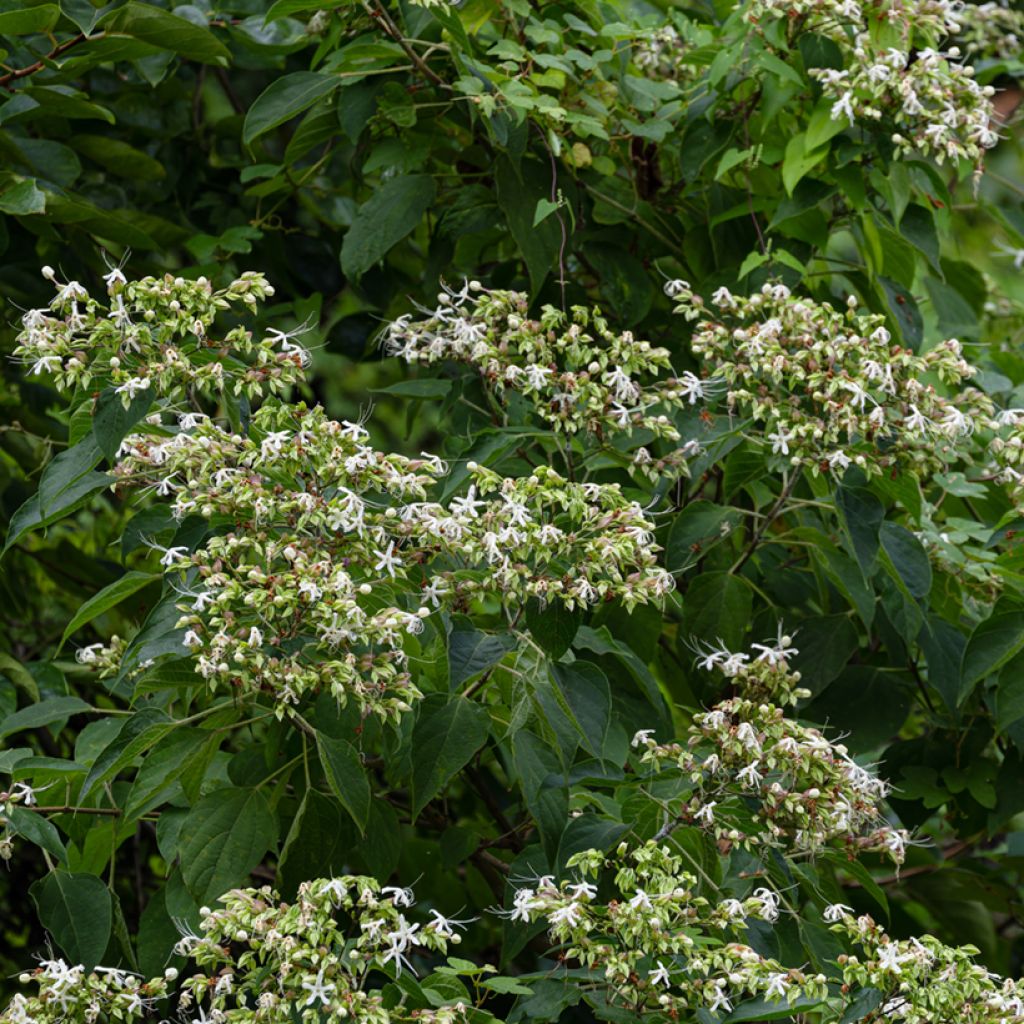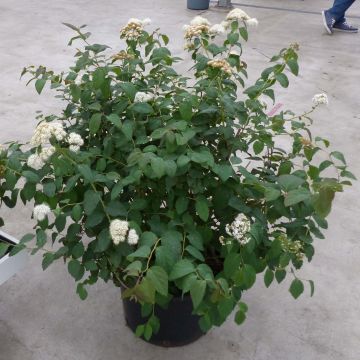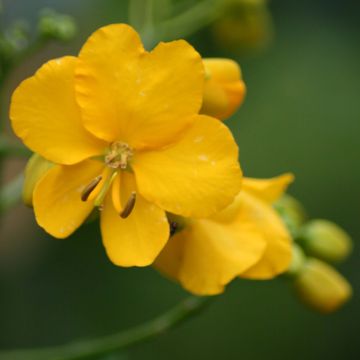

Clerodendrum trichotomum Fargesii


Clerodendrum trichotomum Fargesii


Clerodendrum trichotomum Fargesii


Clerodendrum trichotomum Fargesii


Clerodendrum trichotomum Fargesii


Clerodendrum trichotomum Fargesii


Clerodendrum trichotomum Fargesii


Clerodendrum trichotomum Fargesii


Clerodendrum trichotomum Fargesii


Clerodendrum trichotomum Fargesii


Clerodendrum trichotomum Fargesii
Clerodendrum trichotomum Fargesii
Clerodendrum trichotomum 'Fargesii'
Harlequin Glorybower, Peanut Butter Tree
This new plan, offered as compensation for the previous order, arrived in perfect condition. Quickly planted. Thank you for their commercial gesture and responsiveness.
Franck ,Alsace, 19/11/2023
Special offer!
Receive a €20 voucher for any order over €90 (excluding delivery costs, credit notes, and plastic-free options)!
1- Add your favorite plants to your cart.
2- Once you have reached €90, confirm your order (you can even choose the delivery date!).
3- As soon as your order is shipped, you will receive an email containing your voucher code, valid for 3 months (90 days).
Your voucher is unique and can only be used once, for any order with a minimum value of €20, excluding delivery costs.
Can be combined with other current offers, non-divisible and non-refundable.
Home or relay delivery (depending on size and destination)
Schedule delivery date,
and select date in basket
This plant carries a 24 months recovery warranty
More information
We guarantee the quality of our plants for a full growing cycle, and will replace at our expense any plant that fails to recover under normal climatic and planting conditions.

Would this plant suit my garden?
Set up your Plantfit profile →
Description
The Clerodendrum trichotomum Fargesii is undoubtedly the hardiest form of the Clerodendrum tree. It is a small tree that is as pleasant to contemplate as it is easy to grow in the majority of European regions. It is not widely used in our gardens despite its beautiful fragrant late summer flowering, and its amazing blue and red fruits that remains decorative until winter. As wide as it is tall if not pruned, this Clerodendrum is superb as a standalone plant, in a naturalistic inspired massif, as well as in a flowering hedge.
The Clerodendrum trichotomum belongs to the verbena family. This deciduous species populates the woods and thickets of Japan, Korea, eastern China, and the Philippines, up to an altitude of 2,300 m (7,545 ft). The variety 'Fargesii' is a slightly hardier form (-20°C / -4 °F) native to western China, brought to the Vilmorin Arboretum in France by Father Farges in 1898. It differs from the classic species with its young leaves colored bronze, the green colour of the calyx at the base of the flowers, its glabrous branches and leaves, and fruits that are less vibrant blue than in the typical form.
The Clerodendrum trichotomum Fargesii forms a large and airy rounded shrub, reaching 4 m (13 ft 1 in) in all directions. When care is taken to eliminate the lower branches, it can form a small tree on a stem up to 5-6 m (16 ft 5 in-19 ft 8 in) in height. Severe pruning may induce the appearance of shoots at the base of the plant. The young branches are pubescent, they bear young bronze-coloured leaves in spring. They unfold into large opposing leaves, ovate in shape, with a pointed end and strongly veined. They are of medium green colour and downy on the underside. Larger in young subjects, they can measure 17 to 25 cm (6.7 to 9.8 in) long and 5-15 cm (2-5.9 in) wide and have finely indented edges. When crushed, these leaves emit a curious scent of peanuts, more to the liking of some than others, but which immediately identifies this species. The leaves appear in late in spring and fall at the first frosts.
The abundant and highly fragrant flowering takes place in August-September. The Clerodendrum trichotomum Fargesii tree produces small star-shaped white flowers, carried by an elongated angular greenish calyx, grouped into panicles about 15-20 cm (5.9-7.9 in) wide. The corolla forms a tube terminated by 5 petals from which 4 long stamens and a style emerge. After pollination by insects, the shrub is adorned in autumn with a profusion of berries the size of currants, but dark blue in colour, enclosed in a bright red calyx. This fruiting is more or less regular depending on the year and the climate, and it persists on the branches long after the leaves have fallen.
Make the most of the fragrance of the flowering of Clerodendrum trichotomum Fargesii by placing it near a living or passageway area! In a small garden, plant it as a standalone tree to create shade. It will embellish the area with its intense fragrance and unusual flowering from the end of August to October, when most of the plants in the garden are finishing their blooming. However, avoid parking vehicles underneath as the berries stain and attract birds. The shrub also makes an ideal flowering hedge plant and attracts birds that delight in its fruits. To accompany it, consider shrubs with beautiful autumn colours such as forsythia, Japanese quince, witch hazel, amelanchier, Japanese maple, or remontant yellow roses like Celina. Enthusiasts of rare plants can accompany it with a Euodia daniellii, botanical roses, a deciduous euonymus, a Persian ironwood, or a purple-leaved grapevine with splendid autumn foliage.
Report an error about the product description
Clerodendrum trichotomum Fargesii in pictures








Plant habit
Flowering
Foliage
Botanical data
Clerodendrum
trichotomum
'Fargesii'
Verbenaceae
Harlequin Glorybower, Peanut Butter Tree
China
Other Clerodendrum
View all →Planting and care
Plant Clerodendrum trichotomum Fargesii in a sunny location (or partial shade in hot climates), sheltered from the wind. It prefers light, not too dry or too wet, and relatively fertile soil, but can tolerate any deep and well-worked garden soil. Water well in the first few years after planting, especially during dry and hot weather, to ensure the plant establishes itself well. It flowers on new wood, so it should be pruned in early spring by cutting the stems very low (leaving only 3 buds at the base of the previous year's shoots) to encourage new growth. It may produce some suckers, which are not a problem as they can easily be removed and planted elsewhere. This Clerodendrum is not particularly susceptible to diseases, although it may occasionally be attacked by scaly insects, red spiders, or whitefly. Hardy, it can withstand temperatures down to -20°C (-4 °F) once mature, regrowing from the stump in spring after the above-ground elements have died off. The plant will redevelop tall stems of 1 m (3 ft 4 in) in just a few months, capable of flowering in August-September. In very cold regions, it is advisable to mulch young plants.
The foliage of Clerodendrum Fargesii may take time to emerge in spring. As a result, impatient gardeners sometimes believe it has died and pull it out. Be patient, even if the branches appear dead, the first leaves will not sprout until late April or early May, depending on the region.
Pruning involves clearing the central branches to allow light to penetrate, in late winter (March). Also remove dead wood or any obstructive branches.
Planting period
Intended location
Care
-
, onOrder confirmed
Reply from on Promesse de fleurs
Similar products
Haven't found what you were looking for?
Hardiness is the lowest winter temperature a plant can endure without suffering serious damage or even dying. However, hardiness is affected by location (a sheltered area, such as a patio), protection (winter cover) and soil type (hardiness is improved by well-drained soil).

Photo Sharing Terms & Conditions
In order to encourage gardeners to interact and share their experiences, Promesse de fleurs offers various media enabling content to be uploaded onto its Site - in particular via the ‘Photo sharing’ module.
The User agrees to refrain from:
- Posting any content that is illegal, prejudicial, insulting, racist, inciteful to hatred, revisionist, contrary to public decency, that infringes on privacy or on the privacy rights of third parties, in particular the publicity rights of persons and goods, intellectual property rights, or the right to privacy.
- Submitting content on behalf of a third party;
- Impersonate the identity of a third party and/or publish any personal information about a third party;
In general, the User undertakes to refrain from any unethical behaviour.
All Content (in particular text, comments, files, images, photos, videos, creative works, etc.), which may be subject to property or intellectual property rights, image or other private rights, shall remain the property of the User, subject to the limited rights granted by the terms of the licence granted by Promesse de fleurs as stated below. Users are at liberty to publish or not to publish such Content on the Site, notably via the ‘Photo Sharing’ facility, and accept that this Content shall be made public and freely accessible, notably on the Internet.
Users further acknowledge, undertake to have ,and guarantee that they hold all necessary rights and permissions to publish such material on the Site, in particular with regard to the legislation in force pertaining to any privacy, property, intellectual property, image, or contractual rights, or rights of any other nature. By publishing such Content on the Site, Users acknowledge accepting full liability as publishers of the Content within the meaning of the law, and grant Promesse de fleurs, free of charge, an inclusive, worldwide licence for the said Content for the entire duration of its publication, including all reproduction, representation, up/downloading, displaying, performing, transmission, and storage rights.
Users also grant permission for their name to be linked to the Content and accept that this link may not always be made available.
By engaging in posting material, Users consent to their Content becoming automatically accessible on the Internet, in particular on other sites and/or blogs and/or web pages of the Promesse de fleurs site, including in particular social pages and the Promesse de fleurs catalogue.
Users may secure the removal of entrusted content free of charge by issuing a simple request via our contact form.
The flowering period indicated on our website applies to countries and regions located in USDA zone 8 (France, the United Kingdom, Ireland, the Netherlands, etc.)
It will vary according to where you live:
- In zones 9 to 10 (Italy, Spain, Greece, etc.), flowering will occur about 2 to 4 weeks earlier.
- In zones 6 to 7 (Germany, Poland, Slovenia, and lower mountainous regions), flowering will be delayed by 2 to 3 weeks.
- In zone 5 (Central Europe, Scandinavia), blooming will be delayed by 3 to 5 weeks.
In temperate climates, pruning of spring-flowering shrubs (forsythia, spireas, etc.) should be done just after flowering.
Pruning of summer-flowering shrubs (Indian Lilac, Perovskia, etc.) can be done in winter or spring.
In cold regions as well as with frost-sensitive plants, avoid pruning too early when severe frosts may still occur.
The planting period indicated on our website applies to countries and regions located in USDA zone 8 (France, United Kingdom, Ireland, Netherlands).
It will vary according to where you live:
- In Mediterranean zones (Marseille, Madrid, Milan, etc.), autumn and winter are the best planting periods.
- In continental zones (Strasbourg, Munich, Vienna, etc.), delay planting by 2 to 3 weeks in spring and bring it forward by 2 to 4 weeks in autumn.
- In mountainous regions (the Alps, Pyrenees, Carpathians, etc.), it is best to plant in late spring (May-June) or late summer (August-September).
The harvesting period indicated on our website applies to countries and regions in USDA zone 8 (France, England, Ireland, the Netherlands).
In colder areas (Scandinavia, Poland, Austria...) fruit and vegetable harvests are likely to be delayed by 3-4 weeks.
In warmer areas (Italy, Spain, Greece, etc.), harvesting will probably take place earlier, depending on weather conditions.
The sowing periods indicated on our website apply to countries and regions within USDA Zone 8 (France, UK, Ireland, Netherlands).
In colder areas (Scandinavia, Poland, Austria...), delay any outdoor sowing by 3-4 weeks, or sow under glass.
In warmer climes (Italy, Spain, Greece, etc.), bring outdoor sowing forward by a few weeks.












































